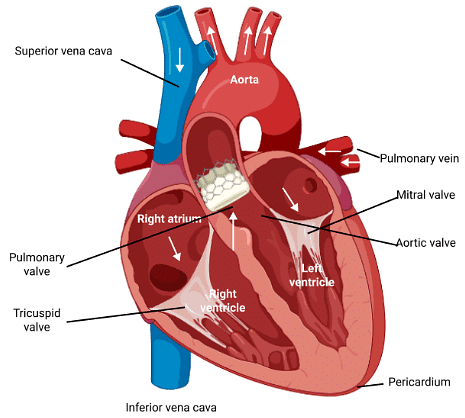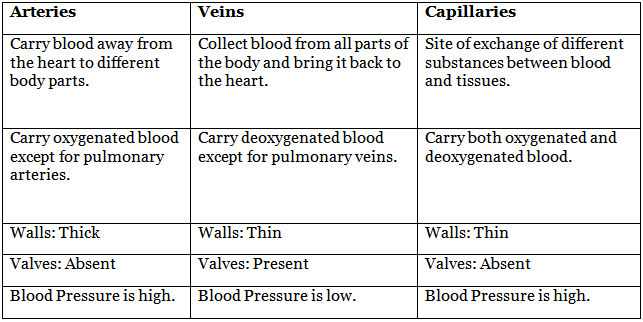Class 7 Science Chapter 7 Question Answers - Transportation in Animals and Plants
Q1. What is the role of blood in the body?
Ans: Blood is the body’s circulatory fluid and is in charge of transporting substances. The following is a list of the functions of blood in our bodies:
- Transports oxygen to all cells of the body.
- It removes carbon dioxide from the body’s cells.
- Transports nutrients to all cells of the body.
- Removes waste from the cells of the body.
- Provides the body with immunity due to the presence of WBC.
- Helps in maintaining body temperature.
Q2. Explain the components of the circulatory system in humans
Ans: Heart, blood, and blood arteries make up the circulatory system in our bodies.
- Heart: It is a muscular organ located in the center of the chest. It is in charge of pumping blood into blood vessels for transportation throughout the body.
- Blood: Blood is a type of fluid tissue that transports substances throughout the body. It is made up of plasma and blood cells. Red blood cells (erythrocytes), white blood cells (leucocytes), and platelets are the three types of blood cells. Each has a distinct purpose in the body.
- Blood Vessels: Blood is carried through these tube-like structures. Arteries, veins, and capillaries are the three types of blood vessels.
Q3. How does transport occur in sponges?
Ans: Transportation in sponges occurs with the help of water. Sponges are aquatic animals. They are always surrounded by water. They do not possess any specific tissue or organ for transportation. Water enters their body through numerous pores present on their body surface and helps in the exchange of materials in the body along with the removal of waste.
Q4. What is transpiration? Explain its importance.
Ans: Evaporation of water from the aerial regions of plants, such as leaves, is known as transpiration. It happens through tiny pores present underside of the leaf surface known as stomata. Roles of transpiration in plants are as follows:
- Transpiration cools down the overall temperature of the plant.
- Transpiration creates a suction pull which helps in absorption from the soil with help of roots.
- It also helps in the removal of waste from plants that are dissolved in water.
Q5. Explain how wastes are removed from the body
Ans: Excretion is the process of removing nitrogenous wastes from the human body. The excretory system is a specialized organ system in the human body that is responsible for elimination. The excretory system consists of a pair of kidneys, a pair of ureters, a urinary bladder, and a urethra. The wastes in the blood are filtered by the kidneys, which then form urine. The ureters transfer the urine produced by each kidney to the urinary bladder, where it is held until it can be excreted by the urethra.
Q6. Explain the structure of the heart with a diagram.
Ans:
The human heart is divided into four chambers. The upper two upper chambers are known as atria and the ventricles are the two lower chambers. The heart is divided into right and left sides. A septum separates the right and left sides completely and prevents the mixing of oxygenated blood with deoxygenated blood.
Valves separate the atria and ventricles, preventing blood from flowing backward.
Q7. How does the transport of food and water occur in plants?
Ans: Plants lack specialized organs and organ systems for substance transportation. Instead, they have specialized tissues for this purpose. A tissue is a collection of cells that share a common purpose. Xylem and Phloem are two vascular tissues responsible for the transportation of water and food in plants.
- Xylem is a tissue that looks like a tube or a vessel but has no cross walls. This is responsible for moving water from the roots to the leaves. The suction force provided by transpiration pull is required for water movement. The loss of water from the aerial regions of plants is known as transpiration.
- Xylem is a tissue that looks like a tube or a vessel but has no cross walls. This is responsible for moving water from the roots to the leaves. The suction force provided by transpiration pull is required for water movement. The loss of water from the aerial regions of plants is known as transpiration.
Q8. What are blood vessels? Compare the different blood vessels.
Ans: The tubes or conduits via which blood is delivered to bodily tissues are known as blood vessels.

|
666 docs
|
















